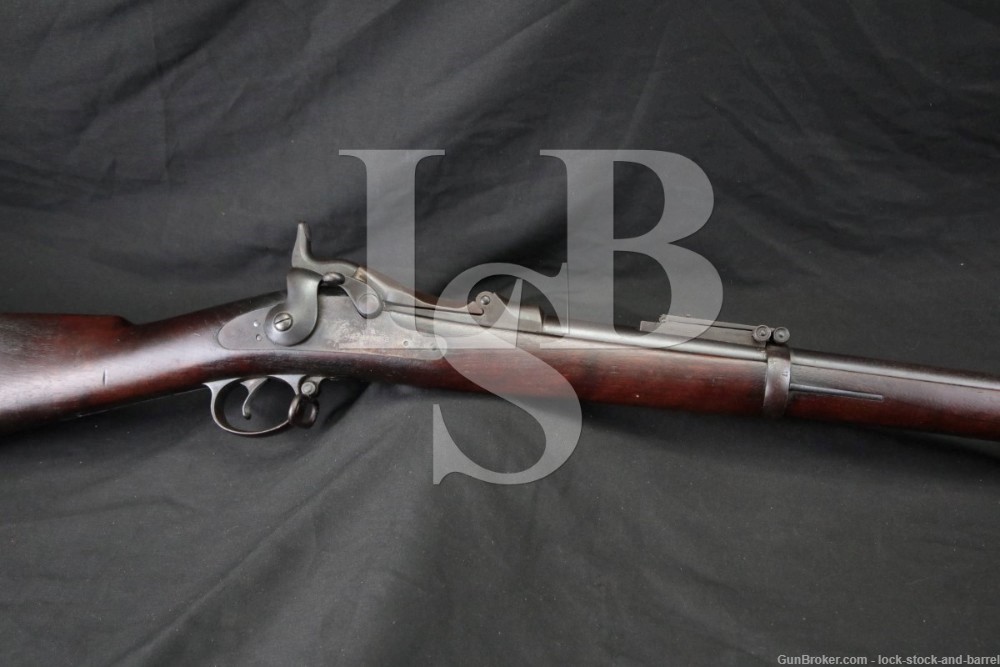
Springfield Trapdoor Model 1888 Ramrod Bayonet .45-70 Rifle Ca 1892 Antique
Sold for $1003.87
LSB#: 220819DW010
Make: Springfield Armory
Model: 1888, “Ramrod Bayonet” Trapdoor Rifle
Serial#: 555934
Year of Manufacture: 1892, Antique
Caliber: .45-70 Govt.
Action Type: Single Shot Trapdoor Rifle
Markings: The breechblock is marked “US / MODEL / 1884”. The rear of the receiver features the serial number. The top of the barrel is marked “A” just ahead of the receiver and “V / P” above an eagle’s head and “P” on the right side just ahead of the receiver. The butt-plate is marked “US”. The lock-plate is marked with the Great Seal of the United States (an eagle) and “U.S. / SPRINGFIELD”. The belly is marked with a “P” inside an oval. The left side of the forend is marked “SWP / 1892” (Samuel W. Porter was the Master Armorer at Springfield). The barrel bands are marked with a horizontal “U”. The right side of the butt is marked “22 / 247”. The comb is marked “D / 31”.
Barrel Length: 32 5/8”
Sights/ Optics: The front sight is a pinned blade. There is also a Buffington style rear sight marked “R” at the front.
Stock Configuration & Condition/ Grip: The stock is one-piece wood featuring a ramrod bayonet seated in the forend, two barrel bands secured by springs (the forward barrel band has two fixed sling swivels), a lock-plate secured by two screws, a sling swivel fixed to the front of the trigger guard, a straight wrist, a straight comb and a semi-crescent butt-plate with a storage compartment. The stock has some light handling marks, nicks and scuffs. Notably, there is a light crack at the rear of the forward barrel band on the left side, scattered light wear on the belly and a few light scuffs on the right side of the butt. The LOP is 13.5” from the trigger to the rear of the butt-plate. The butt-plate is coated in light surface oxidation and has some light handling wear. Overall, the stock is in Very Good Plus condition for an Antique.
Type of Finish: Blue
Finish Originality: Original
Bore Condition: The bore is semi-bright with sharp rifling. There is light erosion and stubborn fouling concentrated in the grooves.
Overall Condition: The rifle retains about 10% of its metal finish. The majority of the gun is now in the white, with some case coloring visible on the concealed portion of the breech-block. The gun is coated in scattered light surface oxidation and it has taken a deep patina color. The gun has scattered light handling marks, nicks and scuffs. Notably, there is light wear along the leading edges. The markings remain clear. The screwheads are lightly tooled and remain serviceable. Overall, the rifle is in Very Good condition for an Antique.
Mechanics: The action functions correctly. We have not fired this rifle. As with all used firearms, a thorough cleaning may be necessary to meet your maintenance requirements.
Box Paperwork and Accessories: None.
Our Assessment: Erskine S. Allin was the Master Armorer at Springfield Armory at the end of the Civil War and was tasked with converting surplus muzzleloaders into more modern breech loaded rifles. Working around the same time as Jacob Snider (an American salesman who patented a breech-loading system which he sold to the British), Franz Wänzl (a Viennese gunsmith who patented a breech-loading system with the Austrian Empire) and several other innovators, the Allin system was born in 1865. All of these systems were quite similar with only minor variations. The Model 1865 was patented in September of that year (several months after the Civil War) and was soon dubbed the “Trapdoor” rifle. The next evolution in the Allin system came a year later and is remembered as the Model 1866 “Second Allin Conversion,” built on M1863 muzzleloaders the gun had improved ballistics over his prior action. The gun was chambered for the then modern .50-70 centerfire cartridge and proved a formidable weapon for its time. Approximately 52,000 of these rifles were converted between 1867-1869, half of which were exported to France for service in the Franco-Prussian War of 1870. The rest were issued to the American soldiers fighting to secure American control over the “Wild West”. In 1873 Springfield Armory began to make trapdoor rifles from scratch chambered for the .45-70 Centerfire cartridge based on the action developed by Allin; these rifles, albeit with a few variations, would remain the standard issue of the U.S. Army until the 1890s when the Krag-Jorgensen was adopted.
This U.S. Model 1888 “Trapdoor” Rifle which was made in 1892. The Model 1888 featured a unique “ramrod-bayonet” and was the last variant of the Trapdoor Rifle to chamber black-powder .45-70 cartridges. Although the production of Trapdoors was discontinued in 1893, some of these rifles would still be in service when the Spanish-American War broke out. There were not enough Krag-Jorgensen rifles available when the U.S. invaded Cuba and Philippines, leaving some American troops armed with Allin’s stalwart, albeit obsolete, design. This particular specimen’s finish has largely worn off, but it remains both aesthetically pleasing with clear markings and it is mechanically sound. This is a great option for historical firearms collectors. Good luck on your bid!
